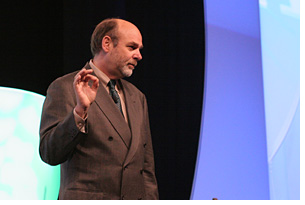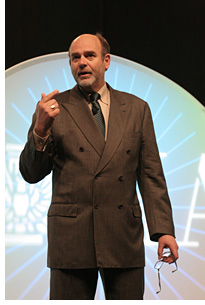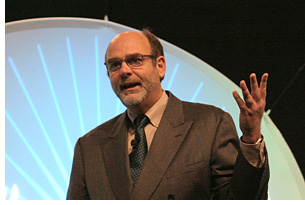

6/2006
Retail consultant Paco Underhill explains consumer behavior, how architects can capitalize

by Russell Boniface
Associate Editor
 His mission, which he has chosen to accept, is to observe shoppers as
they traverse their way in and around a store. And what has he discovered?
His mission, which he has chosen to accept, is to observe shoppers as
they traverse their way in and around a store. And what has he discovered?
“There are too many cooks in the retail design kitchen.”
This is a firm belief of the intrepid Paco Underhill, founder, CEO, and president of Envirosell, a New York-based behavioral market research firm. He has been conducting research on consumer shopping behavior for more than 25 years. Underhill addressed the AIA Convention in Los Angeles on June 10 in his presentation “Why We Buy.” Underhill gave an overview of the space and human factors that govern how consumers move in a store, how visual acuity and perception of time impact the way we shop, what makes a female-friendly environment, shoppers’ unspoken inclinations, and the retail differences between America and other parts of the world. In addition to sharing his experiences, Underhill showed excerpts of telling—and often hilarious—hidden camera video showing unsuspecting consumers in action.
Underhill is something of a retail spy, surreptitiously trolling stores, supermarkets, banks, hotels, stadiums, and malls to observe consumers and how they behave in a physical space. Using a combination of in-store video recording and observation, he and his colleagues observe 50,000 people per year. Underhill’s observations vary from how people enter and walk through a store to how they react to aisle layouts. The surveillance information is then used to help companies design prototype stores. Envirosell's client list includes McDonald’s, Starbucks, Estee Lauder, Blockbuster, Citibank, The Gap, Burger King, CVS, and Wells Fargo. Underhill is the author of Why We Buy and Call of the Mall: The Geography of Shopping.
 Underhill goes undercover
Underhill goes undercover
Paco Underhill didn’t train to become retail James Bond—it
was his training as an urban geographer that earned him his license to
spy. “I am a refugee from academia,” Underhill exclaimed. “Twenty-five
years ago, I was an adjunct professor in environmental psychology, studying
the effect urban space had on people’s behavior, which meant installing
time-lapse cameras, studying bus stops, and evaluating urban trash cans.
“But one day I was standing in line at a bank, getting angrier by the moment. As I stood in line, I realized that the same tools I was using as an urban geographer could be taken inside a building to evaluate the effectiveness of that space. I didn’t know I would later become an expert on how to best sell lipstick, make a dynamic fast-food drive-thru, or where to place signage at a local Target.”
Underhill and his colleagues test facilities worldwide. “Over the last 20 years, I and my colleagues have used over one thousand different measures to observe how people move in a physical space, whether at a retail store, a train station, Yankee Stadium, or a concert hall. We have seen, for example, how much time a person spent at a given place, or whether they actually looked at a sign based on its placement. We don’t ask people their names or addresses, and we are delighted to witness shoplifting because it means that someone is not conscious of us being there. We shoot almost 70,000 hours of videotape each year—some of the most boring videotape you have ever seen—but it will clean your glasses and make you see behavior a little differently.”
Of the 50 largest merchants in the world, Underhill works for half of them. “Merchants and marketers like to measure the efficacy of their efforts through advertising research, such as stopping people while leaving the store, calling them on the phone, or sending them e-mails. I tell these merchants that the problem with that approach is: what consumers think they did, and what they actually did, are often quite different.”
A good example is what Underhill called real time versus perceived time, a result of Underhill clocking a customer’s every move at a store, unbeknownst to the customer. “If I ask someone, ‘how long have you been in the store?’, they might tell me 27 minutes, but I know they have been in there for an hour.”
 Design alone is not the answer
Design alone is not the answer
Underhill maintained that overdesign is problematic. “There are
too many cooks in the retail design kitchen. If I look at the architecture
of the complex and the design of the store, including fixtures, the point
of sales, store windows, packaging, signage, flat-screen televisions—it
adds up to a visual cacophony that is not commercially or aesthetically
satisfying.” Underhill pointed out that our visual language is
evolving faster than our written and spoken word, generating a “visual
acuity” problem.
“Online designers are generally under age 30, and their eyes work differently than aging codgers like me. Twenty percent less light falls on my retina, so I adjust to changing light and adjust my peripheral vision differently. Target each demographic as a distinctive group.” Underhill exhorted too many signs take the discovery out of shopping. He recommended clear and crisp signage, particularly at the cash registers where people are “held captive,” but not at the entrance, where they are not inclined to take in much information. Window signs, displays, and mannequins, he said, best communicate when angled 10-15 degrees to face the direction that people are moving.
Despite award-winning designs, the retail culture is cluttered and ill-focused, Underhill observed. “When store chains struggle, the easiest thing for them to do is to change design, but chains would be healthier if they closed 20 percent of their stores tomorrow. All these stores exist because someone is more focused on the number of store doors, not profits. The cookie-cutters have marginal financial success today.”
For Underhill, one of the ironies in the store design community is that a huge percentage of design-winning stores close within two years, meaning that a design prize has no link to commercial success. “Design alone is not the answer. Does anyone track award-winners two years afterward? E-Trade Bank on Madison Avenue in Manhattan won every prize in 2000 but was ripped out in 2003. Part of the challenge the design community faces now is: How do I get more involved in understanding what people are doing within a store’s parameters?”
 All is not as it seems
All is not as it seems
A good example of knowing what to design is knowing what not to design. “Where
is the real mall entrance?” asked Underhill. “It’s
not the magnificent doorway, but it’s the dark, dismal parking
lot. Don’t spend too much time worrying about the aesthetics of
the main entrance.” Instead, Underhill recommended architects consider
the following elements.
The human factor: If customers enter a store via the main entrance, Underhill explained, Americans tend to turn to the right as they enter. “If you want to get my attention, it better be to my right.” More open spaces for places to sit and eat, especially at malls, where, said Underhill, 40 percent of food is taken to a quiet spot and consumed in an inappropriate place. Lifting a chair over his head, Underhill declared that stores can simply provide more chairs in convenient locations, especially for husbands and boyfriends who aren’t interested in their female partner’s shopping, joking that the men can act as “guard dogs.” If the woman knows the man is comfortable somewhere, then she is more comfortable to keep shopping, he said. More chairs also give women “a place to put her bags down,” which in turns also motivates her to keep shopping.
Underhill doesn’t understand mall traffic patterns. “There is a prescribed walking pattern of up the right and down the left, yet we design our malls as if we walk sideways.” Underhill suggested that malls and department stores group similar products and service, calling it “retail gravity.” Furthermore, Underhill predicted that developers in the United States will soon emulate the European-style mall, which he referred to as an “all.” “People tell us they are more time-pressed than money-pressed, so the idea of crossing a Jiffy Lube with a nail salon is becoming not out of the question. U.S. developers are waking up to the ‘all’ concept, but in the context of our culture, they should consider building into the commercial setting museums, churches, and libraries.”
 Gender
differences (aka the Butt Brush Factor): Underhill noted that “we
live in a world that is designed by men, but yet we expect women to participate,” adding
the majority of shoppers are women, not men. “Whether I am looking
at a hotel, airport, Exxon station, or Victoria Secret, the question
should be: What will make it female-friendly? The gender model has failed.
You may be designing a hardware store, but you better ask yourself: ‘How
do I sell to the wife?’”
Gender
differences (aka the Butt Brush Factor): Underhill noted that “we
live in a world that is designed by men, but yet we expect women to participate,” adding
the majority of shoppers are women, not men. “Whether I am looking
at a hotel, airport, Exxon station, or Victoria Secret, the question
should be: What will make it female-friendly? The gender model has failed.
You may be designing a hardware store, but you better ask yourself: ‘How
do I sell to the wife?’”
And this leads to the butt brush factor.
“Women want more space and privacy,” Underhill said. “They don’t want to be bumped from behind or crowded. The bigger the physical shopping space, the better.” Underhill said there is a difference between male and female in terms of sensitivity. “A women comes equipped with radar . . . I call it the butt brush factor. If a woman stands to look at a display or signage, how long she stands there is defined seminally by how close the traffic pattern moves behind her. A man tolerates it because he has a lot of physical space, but women don’t want their personal bubble crowded.” Underhill suggested avoiding designing narrow aisles and tight display areas, stating that women will remain to shop if they have space to roam.
Malls of the world: Underhill cited examples of niche-oriented, foreign malls. This included a female-owned Brazil mall with an entire floor where men are forbidden to go, replete with a statue of a Great Dane at the entrance; a luxury mall in Costa Rica catered to time-pressed singles who drop laundry off and have it washed, dried, and folded while they shop; and a Tokyo mall with a museum, hotel, and commercial housing. “This sets up the social scene in the context of the mall,” explained Underhill. “This hasn’t happened in North America. Stores here need to evolve from being landlord to place maker; about the details of the social ecology happening right in the store.”
Kids: “Kids can be your allies or your enemies,” Underhill described. “If the child feels welcome, the parent will come in.” Underhill recalled having a Disney executive crawl on the floor to get a three-year-old’s perspective. “Many stores from a three-year-old’s perspective are just not that fabulous. So make sure there's something for them to see at their eye level.” Such ideas as projecting a virtual hopscotch pattern or dinosaur on the floor is all it takes, he said, to turn a boring shopping trip for a child into a friendly experience. “That kid might fall going round and round, but he will be having a good time as the parents shop nearby.”
 Bigger
is not always better. Underhill identified two areas that architects
should keep an eye on: smaller shopping centers with “Ma and Pa” stores
and thrift stores. “The fastest growing retail channel is the anti-design,
neo-village concept. These stores are second and third-tier players,
but focused. It is a New Urbanist movement that has traction, and is
entering suburban development. It’s easier to drive right up, buy
what you want, and leave. It’s also a more fun discovery process.
Also, stylized thrift stores are becoming popular as the social stratification
of consumption goods is ending. Meanwhile, more affluent shoppers buy
offshore. Major merchants and marketers are nervous. We have gone from
what was characterized as a marketing war to what I call a marketing
bar fight, where it is no longer just Bloomingdales versus Saks.”
Bigger
is not always better. Underhill identified two areas that architects
should keep an eye on: smaller shopping centers with “Ma and Pa” stores
and thrift stores. “The fastest growing retail channel is the anti-design,
neo-village concept. These stores are second and third-tier players,
but focused. It is a New Urbanist movement that has traction, and is
entering suburban development. It’s easier to drive right up, buy
what you want, and leave. It’s also a more fun discovery process.
Also, stylized thrift stores are becoming popular as the social stratification
of consumption goods is ending. Meanwhile, more affluent shoppers buy
offshore. Major merchants and marketers are nervous. We have gone from
what was characterized as a marketing war to what I call a marketing
bar fight, where it is no longer just Bloomingdales versus Saks.”
It’s all about the shoes
Although Underhill doesn’t use a shoe phone for his clandestine
retail operations, there is one aspect about shoes that the retail spy
deemed indispensable when evaluating store design. “I believe passionately
in rubber sole shoes,” Underhill concluded. “Whether you
are an architect, CEO, or the latest hire, it is important to go out
there and see what is going on. Then, make the commitment to think standing
up.”
Sage advice from the retail spy master. You now have a mission, should you choose to accept it . . .
Copyright 2006 The American Institute of Architects.
All rights reserved. Home Page ![]()
![]()
![]()